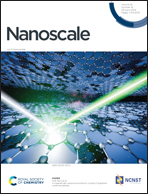Hollow cubic CuSe@CdS with tunable size for plasmon-induced Vis-NIR driven photocatalytic properties†
Abstract
The rational design of the dimension and geometry of a plasmonic semiconductor cocatalyst is vitally important for efficient utilization of near-infrared (NIR) light and superior photocatalytic hydrogen generation. Herein, hollow cubic CuSe@CdS composites with different sizes and strong localized surface plasmon resonance (LSPR) were prepared by selenizing size-tunable Cu2O templates and loading CdS nanoparticles. The size of hollow cubic CuSe can affect the surface area and the conduction band potential through the size effect, regulating the carrier behavior of the CuSe@CdS heterojunction. The CuSe@CdS composites show enhanced and wide absorption in the full spectrum due to the LSPR effect of CuSe. Meanwhile, the composites show excellent photocatalytic hydrogen capacity in the full spectrum in a 0.35 M Na2S/0.25 M Na2SO3 sacrificial reagent solution. The best hydrogen production rate of CSCE2 is 1.518 mmol g−1 h−1 (5.54 times higher than that of CdS) under Vis light (780 > λ > 420 nm) irradiation and 0.28 mmol g−1 h−1 under NIR light (λ > 780 nm) illumination. Interestingly, the photocatalytic activity for H2 under Vis-NIR light (λ > 420 nm) is about 3 times (up to 4.45 mmol g−1 h−1) higher than that without NIR light assistance, due to the photothermal effect. Various analyses and DFT calculations demonstrate that the p–n heterojunction formed in the composites consists of p-type CuSe and n-type CdS, which achieves efficient carrier transfer and separation under the synergistic effect of the size effect and the photothermal effect. In addition, the expansion of the photocatalytic performance to the NIR range is mainly due to the “hot-electron” injection mechanism induced by the LSPR effect of CuSe. The reasonable design coupled with the plasmonic materials offers a new path to achieving the highly efficient conversion of solar energy to hydrogen energy.



 Please wait while we load your content...
Please wait while we load your content...